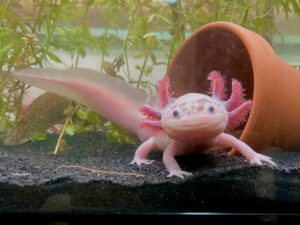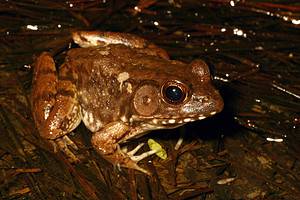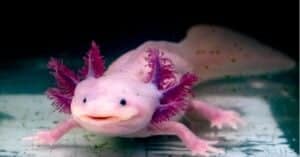Meet the Seymouria, an ancient salamander that gave scientists a hard time with its classification.
Seymouria existed about 299- 251 million years ago. It existed during the Early Permian Period. There are two known species of the ancient salamander. They are Seymouria baylorensis and Seymouria sanjuanensis. The Seymouria was a four-legged animal that moved like the komodo dragon.
The Seymouria had qualities similar to both amphibians and reptiles. Hence, it was hard to classify the animal under one of these categories.
In this article, we’ll see reasons why scientists weren’t sure of how to classify it. We’ll also shed some light on its diet, how it got its name, where the ancient salamander lived, and what caused its extinction.
Amphibian or Reptile?
Seymouria comes from a family of the Seymouriidae. But whether it was an Amphibian or Reptile was inconclusive initially. The reason why scientists had a hard time classifying this two-faced organism correctly is that:
Seymourias had features that made them similar to the early reptiles.
These features include:
- Modification of limbs
- Undulating movements
- Adaptation of skull and hips
And at the same time, they had behaviors that classified them as amphibians.
These include:
- Breathing in water
- External reproduction in water
- Tadpole larva stage discovered in a close relative.
However, the amphibian classification had received a lot of support. It is considered safe to accept that the Seymourias was more of an early amphibian than a reptile. This was mainly because of its tadpole developmental stage.
Description and Size
The name Seymouria meant “From Seymour.” This was an indicator that its fossil deposits were discovered in Seymour, Texas. Seymourias generally were bulky animals. They had a large heads, short necks, stout limbs, and wide, four-clawed feet.
The Seymouria’s skull configuration was very similar to that of ancient tetrapods. It had a boxy shape, and it was roughly triangular when viewed aerially. Also, it was relatively long compared to other Seymouriamorphs.
The Seymouria had an average head-to-tail length of 2 feet. It weighed about 2 to 3 pounds. The male Seymouria weighs more than the female. This is because of the large skull in the male.
The Seymouria, unlike many other amphibians, may have had dry, scaly skin as adults. This must have granted it the ability to conserve water and stay for extended periods on land. The Seymouria is better adapted to life on land. It has long muscular legs that have claws. These claws could have been used for attack and self-defense.
It had a salt gland in its nostrils to regulate the amount of salt in the amphibian body. The glands would excrete excess salt gained by food consumed or from the environment.
However, like most amphibians, the Seymouria would return to the water temporarily. A possible reason for this could be to regulate and cool its body temperature. But most importantly, Seymouria needs water for its reproduction. The Seymouria’s eggs werefertilized externally, and the eggs needed to absorb water for swelling.
- Summary
- Length – 2 ft
- Weight – 2- 3 lbs
- Skin – Dry, scaly skin
Diet- What Did Seymouria Eat
The Seymouria was a carnivore. It had numerous sharp teeth that were used to grasp its prey while swallowing them whole. The Seymouria was a predator that fed mainly on insects, smaller amphibians, sometimes reptiles, and synapsid eggs. They fed on worms and insects during their larval stage. And when they became adults, they retained their taste for insects.
Adult Seymouria also fed on the eggs of megafauna such as the Dimetrodon and Edaphosaurus. However, this was a risky endeavor as the parents can easily eat them if they are caught while raiding the nest. The Seymouria could also feed on already dead carcasses killed by other animals or natural causes.

The Seymouria possibly fed on the eggs of the Dimetrodon, a large and powerful land animal.
©Daniel Eskridge/Shutterstock.com
Habitat- Where and When Did Seymouria Live
As stated earlier, the Seymouria lived during the Early Permian Period. This was about 299- 251 million years ago.
The first specimen species of Seymouria baylorensis fossils, were found in North America and Europe, which shows the animal lived in this region during its time. They were named after their fossils found near Seymour in Baylor County, Texas, North America.
The second specimen species, Seymouria sanjuanensis fossils, were found in Juan County, Utah. The discovery of the second species in a different location is explainable.
This was because, during the Early Permian Period, the five continents had not been separated. They were still joined together as a supercontinent called Pangaea. So, the presence of the second species was due to the continental separation that occurred millions of years after.
The climate in North America during the early Permian Period was semi-arid and somewhat dry. Seymouria would have needed a good means to conserve body water. And as mentioned above, the organism had dry, scaly skin as an adult and often returned to the water to cool off.
The Seymouria spent its early life as a semi-aquatic animal. The egg would hatch in the water as a tadpole. The tadpole would then grow in the water, feeding on worms and insects, as stated earlier. The tadpoles subsequently would come to the surface of the water for oxygen.
Then as an adult, Seymouria would move to spend most of its time on dry land. And the females would then return to the water for spawning.
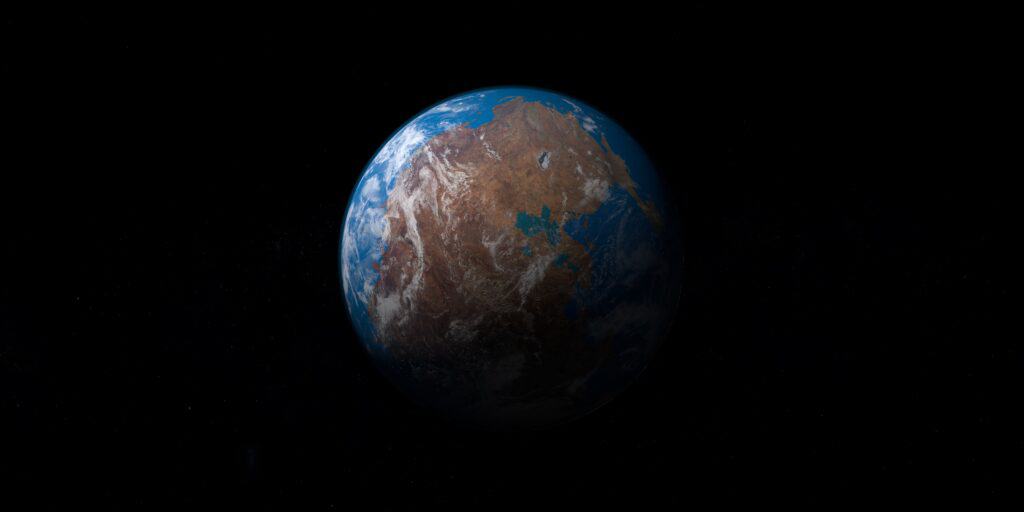
During the early Permian Period, the continents had not yet separated, forming a supercontinent known as Pangea.
©ManuMata/Shutterstock.com
Threats and Predators
Seymourias were not the apex predator in their food chain. Although the Seymouria itself is a predator to smaller amphibians, it was prey to larger animals like the Dimetrodon and Edaphosaurus.
The Dimetrodon and Edaphosaurus were about 3.5 feet long and weighed about 300kg. Seymouria was just too small compared to these giants. It stood no chance in a face-off against them.
The advantage the Seymouria had was that it was faster than its predators. Although the Seymouria is considered a slow-moving creature, it was fast enough to escape its predators.
Natural events like a long period of drought or desertification were a threat to this amphibian predator. Seymourias require water for the reproduction and growth of larvae. A long period of drought can disrupt the reproductive cycle and reduce mating opportunities.
Discoveries and Fossils- When and Where It was Found
The fossils of Seymouria were first discovered near the town of Seymour in Baylor County, Texas. The first species were named after this location, Seymouria baylorensis. The first set of fossils found was a cluster of individual bones. C. H. Stenberg collected them in 1882.
However, the fossils were not properly assembled and identified as Seymouria until 1930. The first fossils named Seymouria included an incomplete skull that was preserved with a few pectoral and vertebral elements. They were described and named by Ferdinand Broili in 1904.
In 1928, the Seymouria was seen as an early reptile, but many other paleontologists were uncertain about classifying the organism as a reptile. They argued, stating its similarities with the amphibian. A summary of the argument was stated at the beginning of this article.
They concluded that Seymouria was central to the evolutionary transition between reptiles and amphibians. But at that time, there was no conclusive evidence to classify the organism as either Reptile or Amphibian.
In 1985, Thomas identified two skulls of the Seymour. After six months of study in 1993, Thomas and David Berman concluded that both skulls belonged to juvenile seymourias.
The second species of Seymouria, Seymouria sanjuanensis, was discovered by Dave Berman in San Juan County, Utah. It was named after its discovery location by Dr. Peter Vaughn, Dave’s advisor. Dave made additional discoveries of five more specimens of this species.
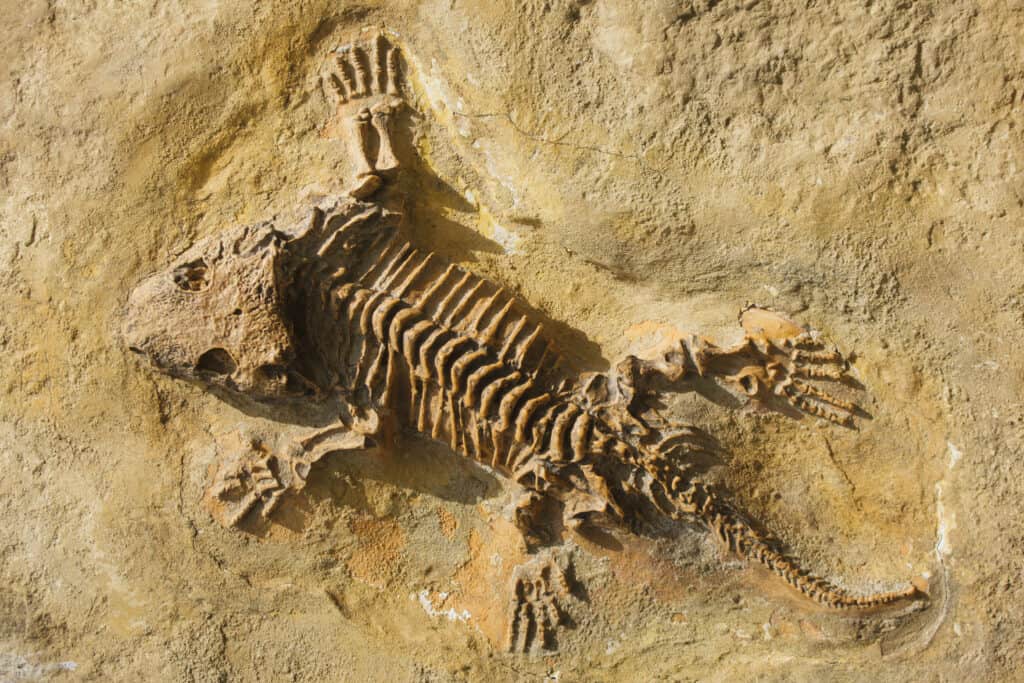
The first Seymouria fossil was discovered near the town of Seymour in Baylor County, Texas.
©Vladimir Wrangel/Shutterstock.com
Extinction- When Did It Die
The Permian extinction, also known as the Permian-Triassic extinction event, was responsible for the death of the Seymouria. This extinction event took place 251 million years ago. It was the most severe extinction event in history.
It brought the extinction of 57% of biological families, 83% of genera, 81% of marine species, and 70% of terrestrial vertebrate species.
The causes of the event were widespread oceanic anorexia, elevated temperatures, and ocean acidification. Ocean acidification was caused by the large amount of carbon dioxide emitted by the Siberian Traps eruption.
Similar Animals to the Seymouria
The Seymouria was an amphibian with features of a reptile. The following are present-day amphibian relations of the Seymouria:
- Giant Salamander: Unlike the Seymouria, the giant Salamander is a fully aquatic animal. It is the largest living amphibian. They are carnivorous. They feed on fish, insects, crayfish, and snails. They can survive for long periods without food.
- Tiger Salamander: The tiger salamander is a terrestrial animal-like Seymouria. It is also found in North America. It is known for its characteristic black and yellow stripes pattern.
Conclusion
The ancient salamander, Seymouria, is the connecting evolutionary link between Amphibians and Reptiles. It is an important transitional fossil that introduced reptile-like skeletal features. This transition was prior to the evolution of amniotes, characterized by amniotic eggs.
The photo featured at the top of this post is © Mirt Alexander/Shutterstock.com
FAQs (Frequently Asked Questions)
Was Seymouria poisonous?
No. The Seymouria wasn’t poisonous.
Can the Seymouria survive in salt water?
No. Seymouria, like other Amphibians, are not tolerant to salt water. Its salt gland is used for minimal salt regulation.
Thank you for reading! Have some feedback for us? Contact the AZ Animals editorial team.



